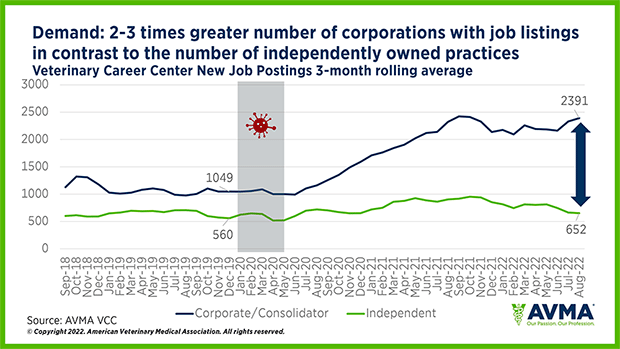
Veterinarian employers require innovative solutions to attract, retain staff members
Retaining and attracting veterinarians has been top of mind for many employers in the industry lately.
The unemployment rate for veterinarians has dropped from 1.8% in 2021 to 0.5% in 2022, according to the 2022 AVMA Census of Veterinarians. Among those in the veterinary profession who are currently unemployed, 79%—or about 1,800 individuals—are not actively seeking employment. That is an increase from 42% in 2018.
“It would be fair to say that all veterinarians who want to work are working or could easily find themselves in a position. Maybe not their position of choice, but a position,” said Charlotte Hansen, AVMA assistant director for statistical analysis. Hansen gave the presentation “The Market for Veterinarians: Examining an Era for Engagement” during the AVMA Business & Economic Forum, held virtually Oct. 24-25.
To recruit, hire, and retain in this new environment, Hansen said, employers will need to create a work environment that is engaging and inclusive and understand what is important to potential employees.

Demand for veterinarians
The AVMA conducted a survey in May among employers who post jobs on the AVMA Veterinary Career Center to get a better pulse on what was happening with employers and their experiences hiring or trying to hire employees.
About 95% of respondents were in private practice, so unsurprisingly, almost 88% of the job postings captured in the survey were for private practice positions. Also among the postings, 93% were for veterinarians, while the other 7% were for veterinary technicians, hospital administrators, practice managers, and the like. Almost 87% of postings were for a full-time position. While 68% of the job postings were to fill a vacancy, 32% were for newly created role.
There was a national average of 1.8 veterinarian job openings per employer, and a national average of 0.6 were filled.
Contributing to the demand for veterinarians is the increasing presence of corporations and consolidation within the profession. According to statistics from the VCC, at the end of 2019, corporate or consolidated practices had a three-month rolling average of 1,049 new job posts, compared with 560 for independent practices. But by August 2022, those figures were 2,391 for corporate or consolidated practices and 652 for independent practices. However, the number of veterinarians going into corporate practices is not matching the increase in available jobs.
In fact, the trend of veterinarians going into corporate practice was at its highest point in 2019 and has since trended slightly downward, according to data from the 2022 Census of Veterinarians.
“Corporations are hiring more but not necessarily employing more,” Hansen said. “There is a desire to attract veterinarians, as we see a lot of advertising on the Veterinary Career Center, but not seeing that necessarily translate to the number of veterinarians entering corporate practice. Or is it that they are accepting a position in corporations and then leaving?”
One piece of good news is that the number of veterinarians who have considered leaving the profession has declined from 44% to 40% in the past year, according to the 2022 Census of Veterinarians.

In the workplace
The nominal mean income in 2022 for all veterinarians is $136,837—or $125,134 in 2021 dollars—up from $118,460 last year.
Hansen said of employers, “Now you may think you’re paying more, but when you adjust for inflation, we are still playing catch up to the salaries pre–2008 financial crisis.”
Along with the increase in incomes overall, full-time veterinarians were working more hours than expected at almost 49 hours a week, compared with 43 hours they expected to work this year. Equine practitioners and veterinarians in advanced education—including internships and residencies—work the most hours, on average, at around 58 hours, compared with the nearly 50 hours they expected to work. Unsurprisingly, equine practitioners and veterinarians in advanced education had the highest percentage—at 32% and 28%, respectively—of veterinarians who indicated they wanted to work fewer hours, according to the 2022 Census of Veterinarians.
Hansen suggested that some ways employers can help retain veterinarians are to adapt the workplace to offer flexible schedules and to offer incentives for the type of candidate they are trying to hire.
She gave the example of a companion animal practice on the North Side of Chicago that did the following:
- Reduced hours of operation.
- Increased salaries by 20% for paraprofessional staff members.
- Remodeled the practice to increase flow and efficiency.
- Empowered paraprofessional staff members to perform all needed duties for the veterinarians, including calling clients with laboratory results and inputting medical notes.
As a result, the clinic was able to reduce the work hours of the veterinarians by 20% while increasing revenues by 20% year over year.
Salary is another area to consider when attracting and retaining veterinarians, but Hansen cautioned employers not to have salary be the only factor.
“You might hire at a rate that is greater than the current long-term, experienced staff,” she said. “So if you’re going to use salary as an incentive, think of the possible unintended consequences to profitability and hospital morale and culture.”
Hiring responsively rather than reactively requires advance planning and care. Practices should have a salary budget, job descriptions, and salary ranges, Hansen said.
“Know the community you’re in and what other businesses are hiring for and what that looks like,” she added.
Finally, she advised that creating socially conscious work environments as well as removing barriers to equity and inclusion in the hiring process and at the workplace are imperative for veterinary employers to attract and retain staff members.
The AVMA provides resources on diversity, equity, and inclusion and recently co-launched Journey for Teams—a multiyear educational initiative to help veterinary workplaces become more diverse, equitable, and inclusive—with the Veterinary Medical Association Executives.
A version of this article appears in the December 2022 print issue of JAVMA.